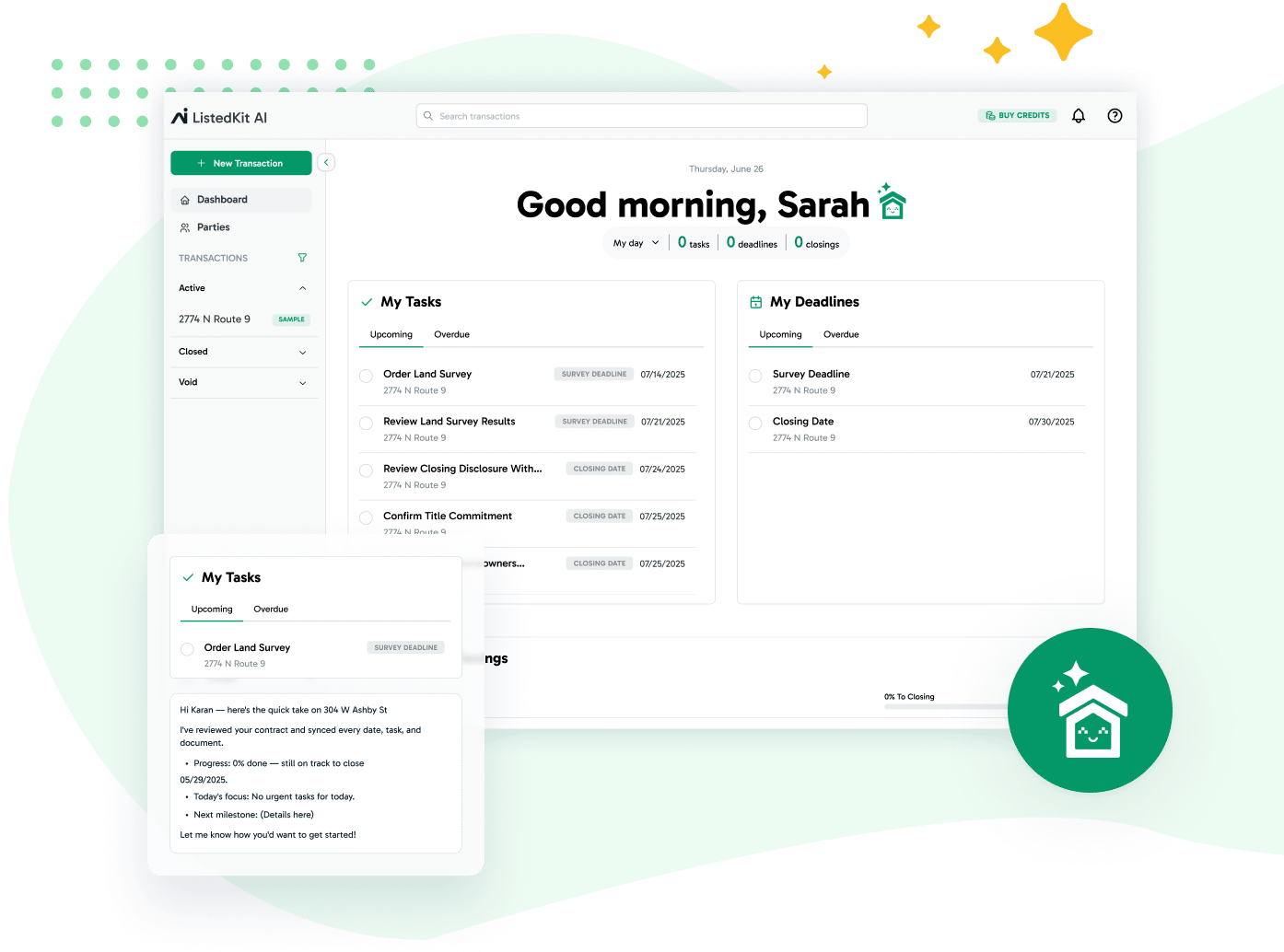Real estate deals have many moving pieces. Contracts, inspections, loan approvals, and closing documents must be carefully coordinated. A systematic real estate project management system helps transaction coordinators and solo agents stay organized, reduce errors, and keep deals on track.
With the right tools and methods, you’ll have a smooth process in place for you, your clients, and everyone involved. This article will discuss everything you need about project and transaction management.
How Real Estate Project Management Keeps Deals Moving
As a solo agent or transaction coordinator, you manage multiple deals simultaneously, each with its schedule, legalities, and client expectations. Without a structured process, administrative tasks pile up, and small mistakes turn into costly delays.
Here’s how a systematic approach helps you stay in charge in the real estate industry:
1. Reduces Administrative Burden
- Keeps transaction tasks organized and reduces manual work. Managing multiple deals means handling a constant flow of emails, documents, and deadlines. A structured project management system assigns tasks automatically, tracks deadlines, and consolidates documents—so you don’t have to manage everything manually.
- Example: A TC juggling five active transactions can use automated reminders to track contingency deadlines instead of setting manual alerts for each deal. The system flags upcoming due dates, allowing you to act in advance rather than react at the last minute.
2. Creates Clear Workflow Structures
- Lays out each step of the transaction process to prevent bottlenecks. A structured workflow provides a step-by-step guide for every deal, ensuring no critical tasks are overlooked. By mapping out transaction phases, you can see exactly where a deal stands and what needs to be completed next.
- Example: When managing a closing, having a pre-built workflow with checkpoints—like appraisal, loan approval, and title review—helps you track progress. If a task remains incomplete, you can follow up before it becomes a problem that delays closing.
3. Improves Real-Time Collaboration
- Keeps all parties updated without the need for constant follow-ups. Coordinating between buyers, sellers, lenders, and agents can lead to overwhelming back-and-forth communication. A project management system with collaboration features centralizes updates, allowing everyone to check progress without sending multiple emails or phone calls.
- Example: A lender waiting on a document from the title company can access a shared system to see if the paperwork has been uploaded. This eliminates unnecessary messages and allows each party to retrieve what they need when they need it.
4. Minimizes Financial Risks
- Prevents missed deadlines that could jeopardize a transaction. Financing delays, missed contingency removals or expired contracts can cost clients money and put deals at risk. A structured system helps you monitor key deadlines and act before they become an issue.
- Example: If a loan approval is still pending a day before the contingency deadline, you receive an alert and can contact the lender for an update. This gives the agent time to request an extension, preventing the buyer from losing the home.
5. Strengthens Client Relationships
- Gives buyers and sellers confidence in the process. Clients appreciate transparency, and a structured system keeps them informed every step of the way. By providing regular updates, you eliminate uncertainty and position yourself as a reliable professional.
- Example: A TC working with a first-time homebuyer can set up automated email updates for each transaction phase, letting the client know what’s happening next. This reduces their anxiety and eliminates repetitive questions.
The Biggest Obstacles in Real Estate Transactions
Even experienced TCs and real estate agents face ongoing challenges when managing transactions. Here are some common bottlenecks:
Missed Deadlines and Critical Tasks
- Loan approvals, contingency removals, and escrow deposits all follow strict schedules.
- A missed step can delay closing, affecting rental income, cash flow, and client trust.
- Task management systems help monitor due dates, preventing last-minute scrambling.
Disorganized Documentation
- Transaction files are often spread across Google Drive, email threads, and personal folders, making it difficult to locate important documents.
- A centralized document management system provides real-time visibility and secure storage for contracts, disclosures, and property details.
Ineffective Communication Channels
- Buyers, sellers, and lenders must stay informed throughout the transaction.
- Relying on scattered emails or phone calls increases confusion and leads to unnecessary delays.
- Using real estate project management software with collaboration features, such as real-time messaging and shared dashboards, prevents information gaps.
Lack of Risk Mitigation Strategies
- Every real estate development project involves legal issues, financial management, and risk control.
- Transaction delays can lead to cost overruns or penalties if deadlines are unmet.
- A well-structured real estate project management system allows real estate firms to anticipate risks before they escalate.
Best Practices for Managing Real Estate Transactions Efficiently
Best Practices for Managing Real Estate Transactions Efficiently
A real estate project management strategy should focus on structure, automation, and organization. With the right tools and workflow, transaction coordinators and solo agents can manage multiple deals efficiently without feeling overwhelmed.
Here are the best practices to keep transactions moving smoothly:
1. Break Transactions into Phases
Without a clear project planning strategy, managing transactions can quickly become chaotic. A structured workflow helps you track each step and identify bottlenecks before they cause delays.
- Divide every transaction into key phases to stay organized:
- Planning Stage. Gather contracts, disclosures, and financing documents.
- Active Projects. Track contingency deadlines, inspections, and loan approvals.
- Completion Stage. Finalize closing documents, disburse payments, and archive records.
- Example. A transaction coordinator handling multiple deals can use a project tracking system to monitor which transactions are in the planning, active, or completion stage. This makes it easy to prioritize tasks and prevent missed deadlines.
ListedKit’s one-stop dashboard provides a clear view of all active transactions, allowing TCs and solo agents to track each deal efficiently without relying on spreadsheets.
2. Delegate Tasks Efficiently to Stay Organized
Managing transactions involves working with multiple parties—buyers, sellers, lenders, title officers, and attorneys. Assigning clear responsibilities prevents miscommunication and delays. Here’s how you can build a workflow that works for you and your team.
- Use task delegation to assign responsibilities and track progress:
- Break down responsibilities among agents, assistants, and other stakeholders.
- Ensure that each task has a deadline and accountability attached to it.
- Example. Instead of manually tracking who collects missing documents, you can use smart checklists to assign tasks to the right parties. The system automatically updates when closing dates shift, ensuring deadlines adjust accordingly.
3. Automate Key Deadlines and Follow-Ups
Automation reduces manual tracking, improves efficiency, and eliminates forgotten tasks. Instead of spending time reminding clients and agents about deadlines, you can use automated alerts and workflows to keep deals on schedule.
- Set up automatic reminders for time-sensitive tasks:
- Configure alerts for contract deadlines, financing approvals, and contingency removals.
- Automate follow-up emails for missing documents or delayed inspections.
- Example. A TC managing multiple deals can use an AI-powered contract reader to extract key dates and due dates from contracts directly. The tool pulls out important details in seconds, eliminating the need for manual data entry and reducing the risk of missing crucial deadlines.
4. Centralize Document Storage for Real-Time Collaboration
Handling multiple deals means managing hundreds of files—contracts, disclosures, inspection reports, and financial documents. A centralized storage system keeps everything accessible, organized, and secure.
- Use cloud-based platforms to store and share documents:
- Securely store transaction records with Google Drive integration or a dedicated real estate management software.
- Provide real-time access to all parties, reducing email back-and-forth.
- Example. A solo agent closing a deal remotely can upload all required documents to a single document storage system. The platform allows attorneys, lenders, and escrow officers to retrieve what they need instantly, eliminating delays caused by missing paperwork.
5. Standardize Communication Processes to Keep Stakeholders Updated
Buyers, sellers, lenders, and agents all need timely updates. Standardizing communication ensures transparency and keeps everyone aligned.
- Use automated updates and shared dashboards to improve collaboration:
- Implement a transaction dashboard where all parties can track progress in real-time.
- Automate status updates on financing approvals, appraisal results, and closing preparations.
- Example. A transaction coordinator managing 10+ deals can use ListedKit’s email automation to send pre-written, auto-filled emails with the latest transaction details. This eliminates repetitive copy-pasting and ensures every message includes the most up-to-date information.
6. Track Performance Metrics & Optimize Workflows for Efficiency
To improve your transaction process over time, you need data-driven tracking. Analyzing performance metrics helps you identify where deals slow down and how to fix inefficiencies.
- Monitor transaction timelines and task completion rates:
- Review delays in financing, inspections, or title work to adjust workflows.
- Identify recurring bottlenecks and refine your process for future deals.
- Example. If financing delays are common in your transactions, use ListedKit’s real estate transaction dashboard to monitor lender approvals in real time. This allows you to flag potential risks early and request extensions if needed, preventing contract expirations.
Choosing the Right Real Estate Project Management Tools
Not all real estate project management software fits the needs of real estate professionals. The right tool should support structured workflows, real-time collaboration, and progress tracking.
Key Features to Look For:
- Task Management & Workflow Automation
- Automated task assignments and deadline tracking for active projects.
- Basic task management features for smaller teams, with advanced features for growing businesses.
- Document Organization & Security
- A real estate construction management system should securely store contracts, compliance documents, and financial records.
- Google Drive, Google Calendar, and CRM integration improve accessibility.
- Effective Communication Channels
- Transaction progress updates should be automated to avoid unnecessary phone calls.
- A real estate management software with built-in messaging improves response time.
- Integration with Other Business Processes
- A tool that connects with customer relationship management, accounting software, and financial planning systems enhances efficiency.
- Scalability for Growing Real Estate Teams
- Some tools offer pricing per user per month, while others allow unlimited users for scalability.
- Choosing software with a monthly flat fee or a good starting price model can help control costs.
Tools like ListedKit provide all the tools needed to create a structured workflow and help TCs and agents manage transactions effectively.
Simple Steps to Keep Every Real Estate Deal on Track
Managing real estate transactions requires organization, efficiency, and the right tools. Without a structured system, deadlines slip, miscommunication increases, and deals become stressful.
A real estate project management approach keeps every task on schedule and reduces last-minute surprises.
Key Takeaways:
- Break transactions into structured phases to track progress clearly.
- Delegate tasks to the right people to avoid miscommunication.
- Automate deadlines and follow-ups to reduce manual workload.
- Store documents in a centralized system for easy access.
- Standardize communication to keep all parties informed.
- Use performance tracking to refine workflows and prevent delays.
Handling all the moving pieces of real estate transactions can quickly get overwhelming. Streamline the process with real estate project management tools like ListedKit. Get started for free!




